Posted by R. John Howe on 12-24-2002 07:29 AM:
"Arch" Better Than "Mihrab"
Dear Steve -
Russell Pickering has also argued against the notion that
what we often call "prayer rugs" were actually used much for that
purpose.
He tends to subsitute "mihrab" and you use that term
occasionally too, in your introductory essay.
I have suggested to
Russell that "mihrab" has some of the same problems as "prayer." That is, it
suggests that the "arch" design in a "prayer" rug is intended to convey either
the notion of "the direction of Mecca" or that of a "symbolic gateway." Like the
"prayer" usage, it is rarely the case that either of these intentions can be
demonstrated.
I think the more neutrally descriptive term "arch," which
is the one you use most frequently here is usually preferrable.
Just a
little pedantry here in the morning.
Regards,
R. John Howe
Posted by Richard Farber on 12-24-2002 10:10 AM:
niche form
Dear Mr Howe
I suggested niche form in a previous salon . . . . if
only becuase some to the forms dont look like they could support a load . . . as
in arch
best regards
Richard
I for one appreciate pedantic
nit pickers . . .
Posted by Steve Price on 12-24-2002 11:15 AM:
Hi Richard,
The Salon essay includes a link to your very relevant Salon on
arch form embroideries in the footnotes, but it probably should have had
more prominence in the text. Anyone interested in prayer rug designs should take
the time to read it over.
Regards,
Steve Price
Posted by R. John Howe on 12-25-2002 02:52 PM:
Dear folks -
Richard Farber's indication that the primary definition
of "arch" suggested something that not only had a "curved shape," but also had a
function, that of "supporting some load," sent me scurrying to my dictionaries
(my learned architectural authority friend upstairs is not available to me
today).
Sure, enough, Richard's suggestion seems to be part of the
primary definition of "arch." Here's what the "Cambridge Dictionary of American
English" has for "arch."
"arch
noun [C]
a structure consisting of
a curved top on two supports which holds the weight of something above it, or
something decorative that has this shape.
Two rows of arches support the
roof of the church.
The arch of your foot is the higher, curved part on
the bottom."
My own usage centered on the "or" part of this
definition.
"Niche" it seems to me now, unless further evidence surfaces,
is, in fact, the preferrable term for this design
feature.
Regards,
R. John Howe
Posted by David R.E. Hunt on 12-27-2002 12:05 AM:
nomenclature
Dear R.J. Howe and All- P.R.J. Ford, in his Oriental Carpet Design, confronts
this semantic dilemma and proposes the term 'archway' as a satisfactory
resolution to this quandary, owning to the fact that the term is merely
descriptive and hence unimpugnable by any symbolic associations. Interesting and
telling, this reference to architecture and/or architectural elements when
attempting to decsribe the prayer rug, for I believe a compelling argument would
assert that many forms of the "prayer rug"design are in fact the manifestations
of various architectural elements, such as the mihrab, the niche, the minaret,
and the cloumned arch. This is of course not always readily or immediately
apparent, especially as in the case of that which appears to be a design
evolution exhibited by the
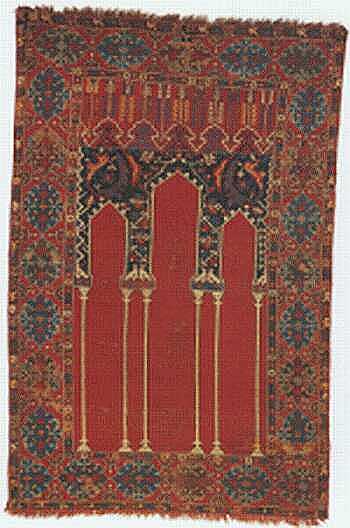
early "Multi column Ladik" and it's metamorphasis into
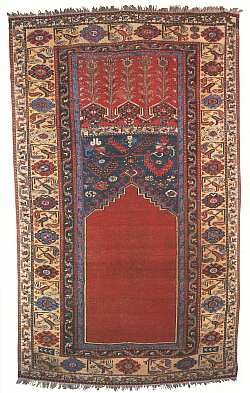
the " traditional" Ladik,
then into the latter version in which the "crenulation and tulip" motive of the
design is
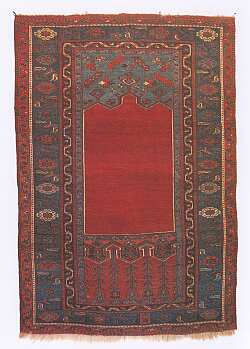
inverted and placed at the base of the columns as if in some
misguided attempt to balance the design. Next we find
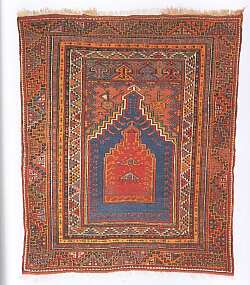
the Mudjar and Kirsehir "prayer
rug", a simplified geometric rendition of this same Multi column Ladik design in
which the relative proportions of the various design elements have changed once
again. And at the terminus of this evolutionary spectrum ,as exemplified in a
weaving by
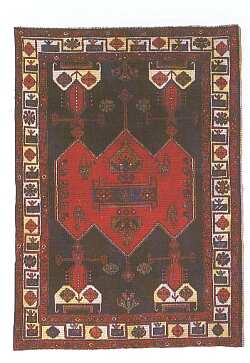
the Kurdish
Kolyai tribe, the design is reduced to an angular medallion suggestive of the
archway and only vestigal details by which to clearly identify the design for
what it represents. I would suggest that we use the architectural term when it
is readily apparent that the motive in question is in fact an architectural
rendering, and the descriptive in others. Not that I will lose sleep if you fail
to do so.
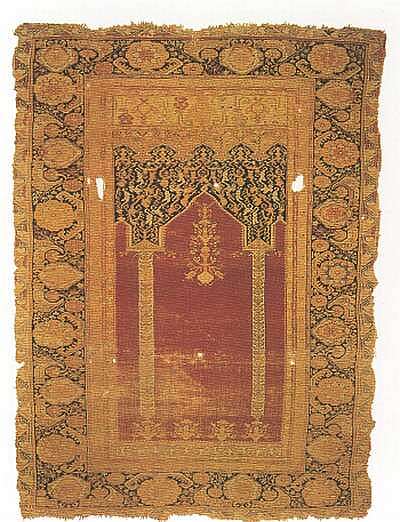
This
last rug, besides being I believe, verry old and beautiful, is interesting in
that it seems to incorperate into it's design the characteristics of a variety
of styles of prayer rugs, including both the columnar and Classic Ladik and the
Gordes/Transylvanian rugs, and suggests, at least superficially, some
relationship between them all, and in the least with that of Ottoman court
Carpets. - Dave
Posted by Filiberto Boncompagni on 12-29-2002 04:49 AM:
Hi folks,
No time to participate to the discussion, so far.
This is
only to let you know that the images are now inserted in Dave’s
posting.
Regards,
Filiberto
Posted by David R.E. Hunt on 12-29-2002 09:08 AM:
Early vs Latter
Dear All- Just as important afterthought, it should be noted that early ladik
prayer rugs may still exhibit the characteristic of crenelation and tulip panel
being placed below the archway- the archways in the older rugs are
proportionally larger than the other design elements- Dave
Posted by Filiberto Boncompagni on 01-02-2003 11:18 AM:
Dear John,
Coming back to the topic of "Arch" better than
"Mihrab"…
I was offered a book, Selected Precius (SIC) Rugs of
Dafineh Museum with text in Farsi and (bad) English.
I learned that the
Dafineh is a rather recent museum in Teheran.
Among the illustrations there
are several examples of Persian rugs with arches - some of them with columns and
central lamp which WE commonly identify as "prayer rugs", others with arches and
trees, vases and flowers.
Interestingly the captions describe them only as
Disign (SIC) : MEHRABI with, according to the case COLUMNAR,
CONDYLED (?) VASE SHAPED, TREE.
No mention of Prayer or
Arches.
Regards,
Filiberto





